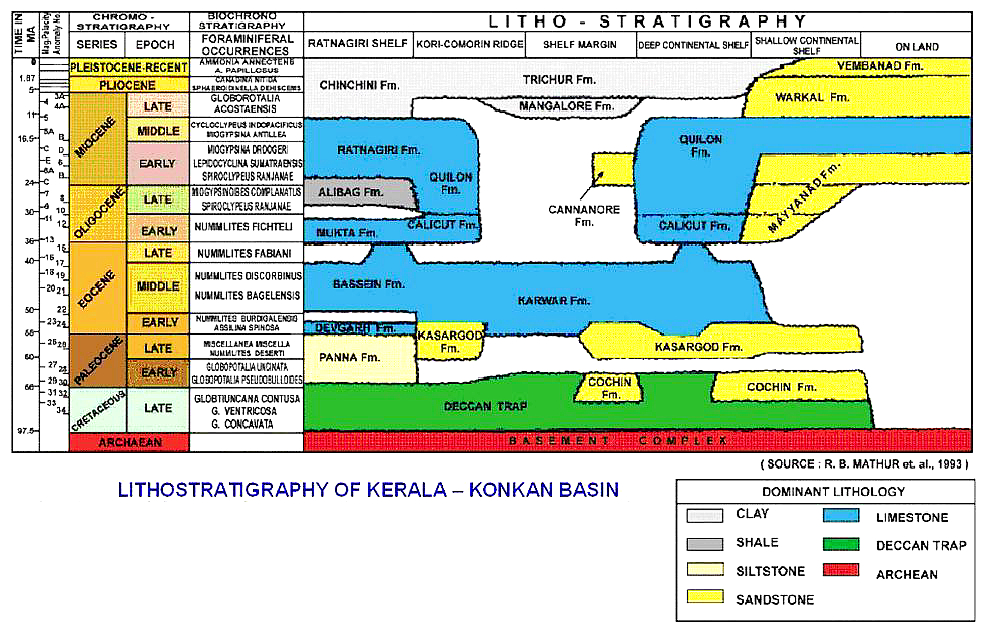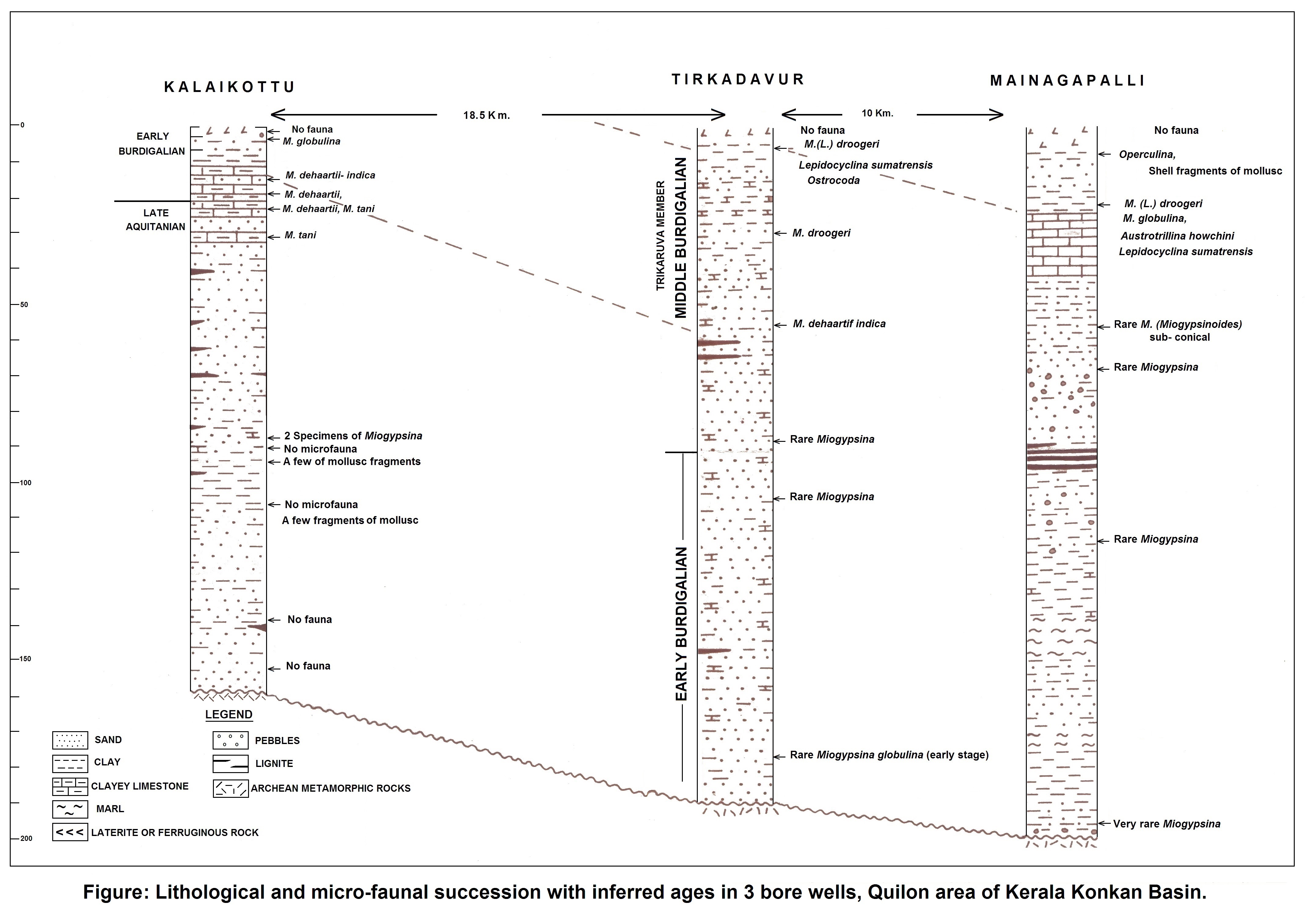Quilon Fm
Type Locality and Naming
OUTCROP and SUBSURFACE: Outcrop near Padapakkara. [Original Publication: King, W., 1882: The Warkali beds and associated deposits at Quilon in Travancore, Rec. Geol. Surv. Ind. Vol. 15 (2). pp. 93-102]. Reference well: Well CH-1-1, Interval between 430-1324m and thickness is 1094 m
[Figure 1: Outcrop location map of Padapakkara Quilon area of Kerala Konkan Basin (after Raju 1973)]
Synonyms: The Quilon beds of King (1882) form patchy outcrops in the on-land part of the Kerala Basin. These were designated as Quilon Fm by Raha et al., 1984.
Lithology and Thickness
Limestone. In type section this formation comprises of brownish white to dirty white, buff and grey foraminifera-algal wackestones and packstones. These are dolomitized in several intervals. The limestones are chalky at places. Occasionally thin bands of grey to dark grey, soft and sticky claystones are also observed. Offshore drilling has established that the formation has a wide areal extent and continues in the north as Ratnagiri Fm. Towards basin margin, more of calcareous clays and sands occur specially in the upper part as seen in well K-1-1.
[Figure 2: Lithological and micro fossil log of the Quilon Limestone and adjacent beds at the Channa Kodi type locality (after Reuter et al., 2010)]
Subsurface Lithology – This formation generally consists of limestone with thin shale/claystone bands. Laterally towards basin margin it is represented by clays and sand in Well K-1-1 and towards offshore sandy lithology is present in Wells KK-OS-VI-I, KK-OS-II / B-1 and CSP-1. Dolomitization is observed at various levels.
[Figure 3: Lithostratigraphy of Kerala-Konkan Basin (from dghindia.gov.in)]
Relationships and Distribution
Lower contact
Lower boundary is unconformable with Mayyanad Fm or Bassein Fm.
Upper contact
Upper boundary is unconformable with Warkali Fm.
Regional extent
GeoJSON
Fossils
From the type section Pseudotabulina malabarica was originally described. Raju (1973, unpublished) recorded Miogypsina globulina-thecideaeformis, Miogypsina tani, Miogypsinoides dehaartii, Miogypsina (lepidosemicycliuna) droogeri, M. (L.) excentrica.(after Raju and Misra, 2009).
Subsurface Biostratigraphy – Larger benthic foraminifera M. (Miogypsinoides) complanata, Miogypsina tani, Miogypsinoides dehaartii, Miogypsina (Lepidosemicyclina) droogeri, M. (L.) excentrica
Age
Depositional setting
Marginal marine to inner shelf
Subsurface Depositional Environment – Inner neritic environment
Additional Information
Other important localities for Quilon Fm –
1. Chavara borehole: (Lat. 26o 32’ N; Long. 80o 58’E): Jacob and Sastri (1952) recorded diagnostic foraminifer taxa Lepidocyclina (Nephrolepidina) sumatraensis, Austrotrillina howchini and Archais and suggested Burdigalian age.
2. Edavai dug Well: Fossiliferous clays are encountered at depths below 10 meters in wells dug for water in Edavai. Samples from one well dug up to a depth of 24.5 m below the ground level, contains foraminifera including Miogypsina sp., and Miogypsinoides dehaartii.
3. Kalaikottu Well: (Lat. 8o 47’ 45” N; Long. 76o 40’ 40”E): The lithological and microfossil succession with inferred ages of 3 borewells Kalaikottu, Tirkadavur and Mainagapalli is given in the figure 3. The lithological succession is the presence of lenses of lignite at several levels below the limestone beds. From the well cuttings available, it is not clear whether the lower part of the unfossiliferous section in this well, particularly the one between 110 and 158 meters, could be allocated to the Warakali Fm or the Quilon Fm. The succession of Miogypsinidae from depths between 35 and 6 meters in this well include: Miogypsina tani Drooger, M. (Miogypsinoides) dehaartii, Vander Vlerk, M. (Miogypsinoides) dehaarti- indica, M. globulina and other foraminifera includes Lepidocyclina and Operculina; belong to M. tani Zone and early part of M. globulina- thecideaeformis Zone equivalent to the Late Aquitanian and Early Burdigalian (Raju, 1974). The lithological succession between 158 m and 110 m is unfossiliferous and doubtfully designated as Warkali Fm.
[Figure 3: Lithological and micro-faunal succession with inferred ages in 3 bore wells, Quilon area of Kerala Konkan Basin. (after Raju, 1973)]
4. Tirkadavur Well: (Lat. 8o 55’ 10”N; Long. 76o 36’ 20”E): The lithology in the lower part is calcareous sands with rare lignite layers, contains foraminifer taxa include Miogypsina globulina, M. dehaartii indica suggestive of Early Burdigalian. The upper part consists of M. (L.) droogeri and Lepidocyclina sumatraensis.
5. Mainagapalli Well: (Lat. 9o 2’ 15”N; Long. 76o 34’ 30”E): Claystone/ shale with few lignite layers are present in the lower to middle part and Limestone occurs towards the upper part of the well section. The index foraminifer taxa include M. (L.) droogeri, Austrotrillina howchini, Lepidocyclina sumatraensis suggestive of Middle Burdigalian age are recorded in this section.
6. Bore hole at Quilon: Singh (1998) recorded important planktic foraminifer assemblage belonging to Globigerinatella insueta Zone (Zone N7, Upper part of Burdigalian stage) and Praeorbulina glomerosa and P.sicana of P. glomerosa Zone (Zone N8, Langhian stage) from a borehole at Quilon.


